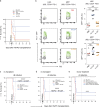M-CSF improves protection against bacterial and fungal infections after hematopoietic stem/progenitor cell transplantation
- PMID: 27811055
- PMCID: PMC5068229
- DOI: 10.1084/jem.20151975
M-CSF improves protection against bacterial and fungal infections after hematopoietic stem/progenitor cell transplantation
Abstract
Myeloablative treatment preceding hematopoietic stem cell (HSC) and progenitor cell (HS/PC) transplantation results in severe myeloid cytopenia and susceptibility to infections in the lag period before hematopoietic recovery. We have previously shown that macrophage colony-stimulating factor (CSF-1; M-CSF) directly instructed myeloid commitment in HSCs. In this study, we tested whether this effect had therapeutic benefit in improving protection against pathogens after HS/PC transplantation. M-CSF treatment resulted in an increased production of mature myeloid donor cells and an increased survival of recipient mice infected with lethal doses of clinically relevant opportunistic pathogens, namely the bacteria Pseudomonas aeruginosa and the fungus Aspergillus fumigatus M-CSF treatment during engraftment or after infection efficiently protected from these pathogens as early as 3 days after transplantation and was effective as a single dose. It was more efficient than granulocyte CSF (G-CSF), a common treatment of severe neutropenia, which showed no protective effect under the tested conditions. M-CSF treatment showed no adverse effect on long-term lineage contribution or stem cell activity and, unlike G-CSF, did not impede recovery of HS/PCs, thrombocyte numbers, or glucose metabolism. These results encourage potential clinical applications of M-CSF to prevent severe infections after HS/PC transplantation.
© 2016 Kandalla et al.
Figures






References
-
- BitMansour A., Burns S.M., Traver D., Akashi K., Contag C.H., Weissman I.L., and Brown J.M.. 2002. Myeloid progenitors protect against invasive aspergillosis and Pseudomonas aeruginosa infection following hematopoietic stem cell transplantation. Blood. 100:4660–4667. 10.1182/blood-2002-05-1552 - DOI - PubMed
-
- Bodine D.M., Seidel N.E., and Orlic D.. 1996. Bone marrow collected 14 days after in vivo administration of granulocyte colony-stimulating factor and stem cell factor to mice has 10-fold more repopulating ability than untreated bone marrow. Blood. 88:89–97. - PubMed
MeSH terms
Substances
LinkOut - more resources
Full Text Sources
Other Literature Sources
Medical
Research Materials
Miscellaneous

